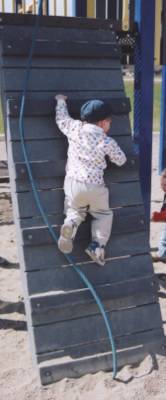Today's column, published in the London Free Press, pretty much confirms where we've been and what we've been doing for the past little while. I thought the journey mattered almost as much as - if not more than - the destination, hence the piece, Vacation drive burns into kids' memories.
Tomorrow we set off on the return trip. I hope it'll be just as memorable as the trek down.
Be home soon.
--
DEERFIELD BEACH FL. - The mathematics of driving huge distances with your kids don’t always add up. Sometimes they add up in ways you never expected.
When my wife and I first decided to spend our winter vacation in Florida, we thought driving down would be a unique way to put our own stamp on a couple of weeks away from the cold and snow.
We both grew up in families that drove - often - to see family. Some of our richest memories come from the road. Dark motel rooms that sort of all looked the same, roadside diners that looked and smelled different than anything we’d ever known, scenery that made home look ordinary and boring.
The journey was always the adventure. How we got there - and what we experienced along the way - was often just as important as what we did once we arrived.
We wanted our kids to experience that as well. The numbers, however, were daunting.
First, the distance: 2,375 kilometers. Strictly observing speed limits, that’s 24 hours on the road, Factor in the tiny bladders of children that absolutely have to be emptied every other exit and it’s no wonder it usually takes two or three days to get there.
Second, we’ve got three children. They outnumber us. This is bad enough when we’re home, but it only gets worse on the road. From keeping them out of the path of oncoming motorists in parking lots to negotiating who gets to decide where we eat lunch, vehicular peace amongst three children is about as challenging to maintain as election-eve security in Iraq.
To balance these odds somewhat, we brought along a television. We always swore we would never use TV to anesthetize our children. But the tube - actually, a portable DVD player - bought us some sanity. Ordinarily, they’d ask, “Are we there yet?” before our van had even cleared the first highway on-ramp just outside London. Instead, we were rewarded with occasional, blissful silence; just enough to break the monotony of being strapped into a booster seat for two marathon days.
But the number that overshadowed all was the seemingly limitless number of firsts that our children have experienced since we’ve been here.
Dahlia, 7, gasped with delight when she saw her first palm tree alongside the road in southern Georgia. Noah,4, almost bounced out of his seat when we passed the first orange grove in northern Florida. Zachary, 10, tried hard to contain his excitement as we rounded the corner and saw the pounding surf of the Atlantic Ocean.
We took hundreds of pictures along the way to try to capture the magic in their eyes as they experienced things they never had back home. The photos are lovely, but the really vivid images are the ones a lens cannot ever come close to capturing, the ones that play in the photo album of their minds.
As a parent, it’s hard to ignore just how big these little moments can be in a child’s life. I was nine when I first played on a Cape Cod beach, yet it feels like yesterday. I hope my son always looks back to his moment on his beach with a comforting smile.
In a couple of days, we’ll pack up the van for the return trek. Instead of shedding clothes as we approach a sunny destination, we’ll pack on additional layers as the temperature drops and work and school loom larger in the windshield.
And after we’re back home, scraping ice from the car and piling our bundles of unlimited potential into their car seats, I hope they fondly recall their trip to see their grandparents, just like my wife and I still hold onto images of our own childhood adventures.
Sure, we’ve relaxed during our too-short time here. But we’ve also hopefully left our children with the gift of indelible memories. We’ll try to add to them next year, too.
---
Carmi Levy (carmilevy@msn.com) is a London freelance writer. His column appears every other Wednesday.
-30-


















